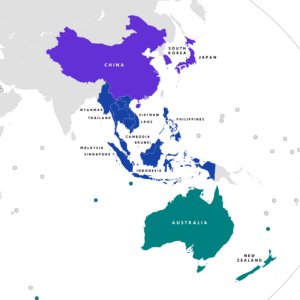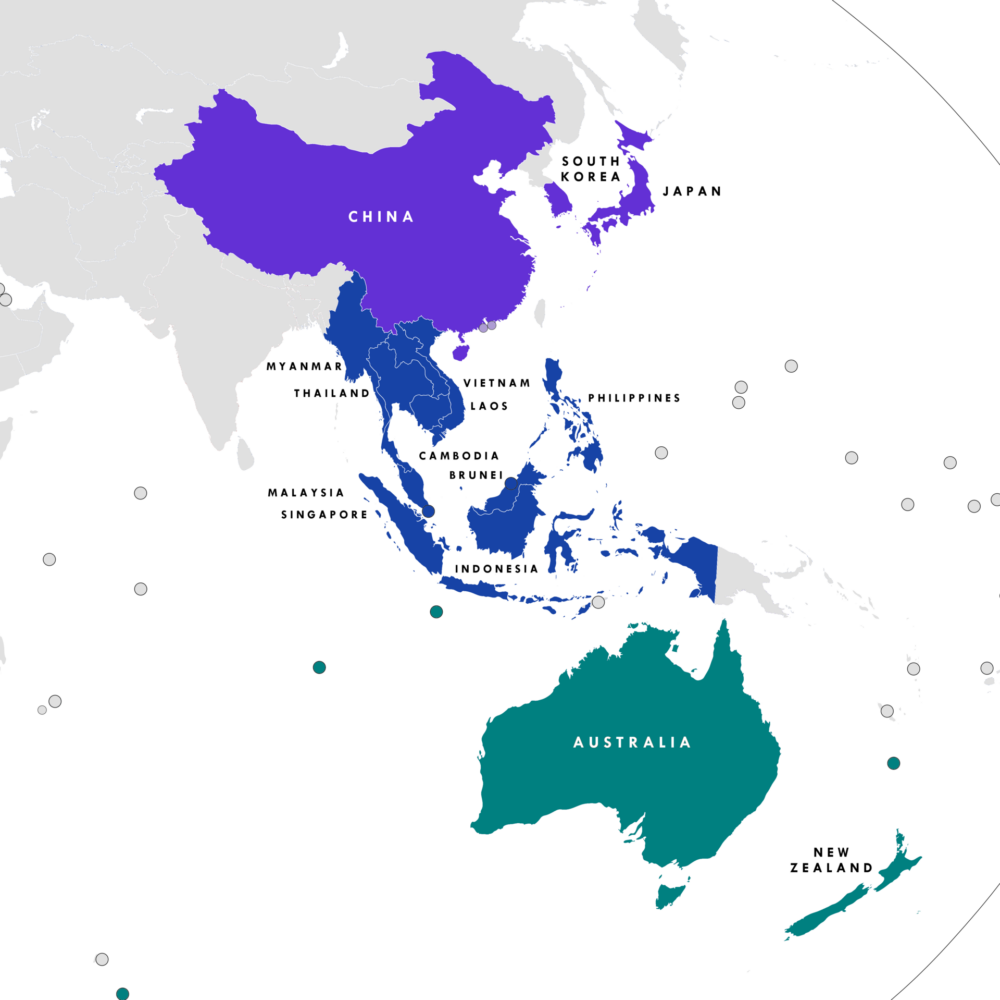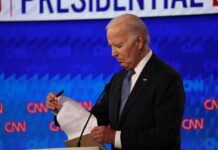Vincent Kolo, chinaworker.info
On 15 November the Regional Comprehensive Economic Partnership (RCEP) was launched by fifteen governments in the Asia-Pacific region. The clear intention of the negotiators was to launch a typically neoliberal trade agreement, which if fully implemented will reduce tariffs and non-tariff barriers between the ten members of the Association of Southeast Asian Nations (ASEAN) and five non-ASEAN economies. ASEAN consists of Brunei, Cambodia, Indonesia, Laos, Malaysia, Myanmar, Philippines, Singapore, Thailand, and Vietnam. The five ‘outsiders’ are Australia, Japan, South Korea, New Zealand and the regional superpower, China.

RCEP is billed as the world’s largest trading bloc encompassing 2.2 billion people (of which China accounts for 63 percent) and around 30 percent of global GDP (with China accounting for more than half of this). The deal is likely to encounter massive resistance from workers’ organisations and social movements across the region, and sharp contradictions among the signatory governments raise a lot of questions about its viability.
Here chinaworker.info offers four takeaways from the RCEP’s launch.
RCEP represents a huge attack on workers, farmers and nature
The RCEP is a gigantic crime perpetrated by a secretive clique of capitalist politicians and business magnates against the vast majority of the Asia-Pacific region’s people. “It will further undermine the livelihoods of farmers, fishers, indigenous peoples and rural women, and threaten jobs for workers,” says the group Trade Justice Pilipinas. “RCEP will only deepen inequalities that already exist and were exacerbated further by the pandemic,” the Philippines-based group warns.
Seven trade unions spanning several countries in the region described the timing of the agreement as “appalling”, coming in the midst of the worst pandemic for a century, with health systems overwhelmed and unemployment rising sharply. They warn that RCEP threatens to deepen what the United Nations predicts could be the worst global food crisis in 50 years.
Asia’s economy as a whole will shrink by -2.2 percent this year, according to the IMF’s latest survey, the first such contraction since the 1960s. Even in the devastating Asian financial crisis of 1997, the economy of the whole region achieved positive growth of 1.3 percent. The RCEP deal shows desperation more than anything else on the part of the fifteen governments; the need for a positive narrative to sooth business nerves and revive foreign investment.
RCEP will increase the exploitation of workers and the environment. The reorganization and regionalization of supply chains, envisaged under RCEP will trigger mass layoffs, business closures, wage cuts and an increase in already unacceptable levels of precarious employment. The ILO reports that 68 percent of the Asia-Pacific’s labour force is in the informal sector, with young workers 15–24 most affected. In these jobs there is almost no social protection, no pension rights or trade union rights. In Laos and Cambodia, two RCEP states, the informal sector accounts for over 93 percent of employment, but even in wealthy Japan it is 20 percent.
Land grabbing, forced clearances and impoverishment of small-scale subsistence farmers will increase. RCEP mandates its members to join the Budapest Treaty, which enforces monopoly control over seeds and microorganisms by big agrochemical companies like Monsanto and China-owned Syngenta, further weakening the position of small farmers. Healthcare professionals warn RCEP rules on generic drugs, if adopted, will lead to crippling medicine prices in many ASEAN countries.
Already degraded ecosystems will be stressed further. In Indonesia, an area of forest the size of Brunei is lost every year to big companies in the plantation, logging and mining industries. Mass battles have broken out in recent years involving environmental activists and indigenous peoples — from West Papua to Inner Mongolia — to block mining and other ecologically destructive corporate projects. This includes protests against Chinese companies and infrastructure projects in Indonesia, Thailand, Myanmar and other RCEP states, including projects under China’s giant Belt and Road Initiative (BRI).
RCEP contains no environmental provisions. The fight to defuse the ecological and climate time bomb and improve conditions for Asia’s rural poor cannot be based on lobbying to ‘improve’ RCEP, but by demanding the deal is scrapped. Strong workers’ organizations, linking with and giving a lead to the rural masses, are the only way to defeat the capitalist onslaught. Workers’ internationalism and common struggle to end the capitalist profit system and put all economic resources under the democratic control of the majority is the only answer, rather than the illusion of ‘national’ capitalism and protectionism.
RCEP means new attacks on democratic rights
RCEP is an “affront to democracy” says leftist Philippine MP Sarah Elago. “Governments have given privileged positions to large business lobby groups at the expense of basic democratic principles” she points out. RCEP negotiations were conducted in complete secrecy, excluding elected parliamentarians (where they exist), let alone trade unions, youth organisation or rural campaigners. The final 510-page document, with thousands of pages of associated documents, was not released until after the deal was signed. Yet powerful capitalist combinations like the East Asia Business Council, Japan’s Keidanren and the Minerals Council of Australia were even given a formal role in the RCEP process.
The acceleration of land-grabbing and corporate seizure of natural resources will lead to increased militarization and state-backed terror in rural and ethnic minority regions. Mass protests of workers and youth in Indonesia, Thailand and Hong Kong in the past year have met with severe repression. Across the region military spending is rising, by 52 percent in the decade to 2018, according to the Stockholm International Peace Research Institute.
The RCEP process shows that when deals to increase the profits of big companies are on the table, there are no fundamental differences between outright dictatorships such as in China, Brunei and Laos, and ‘democratic’ capitalist governments in Australia, Japan and New Zealand.
RCEP: Who wins, who loses?
RCEP and other FTAs are manifestations of modern imperialism, which allow the capitalist classes to more effectively exploit labour, both at home and globally. Three countries — China, Japan and South Korea — will reap 90 percent of the income gains and 88 percent of the trade gains from RCEP, according to economist Michael Plummer. The remaining twelve RCEP members will be left to squabble over the crumbs.
All capitalist agreements try to dupe the people with sugary phrases about “win-win cooperation” in which everyone benefits. But for the mostly ‘developing’ economies of ASEAN, RCEP will reinforce a process of economic dependency — as markets, sources of cheap labour and natural resources — on Chinese capitalism and other big economies.
In the past ten years, half of ASEAN’s members have run a trade deficit (Cambodia, Indonesia, Laos, Myanmar and especially the Philippines). Trade Justice Pilipinas warns that RCEP membership will increase the country’s imports bill by US$908 million but only add US$4.4 million to the value of exports.
China’s imperialist character under the rule of the so-called Communist Party (CCP) is fully revealed by its instrumental role in unleashing this neo-liberal project upon the peoples of the region. The CCP’s economic and geopolitical ambitions, which in the era of Xi Jinping are increasingly pursued by means of coercion and threats, are not fundamentally different from more established imperialist powers like the US.
China’s need to consolidate its domination over East Asia, as a counterweight to the economic and diplomatic Cold War ‘decoupling’ policies of the US, is a critical factor behind the launch of RCEP. It represents a further significant escalation of the Cold War, rather than any scaling down. Xi’s regime knows that when Biden is sworn in, Washington’s anti-China policies will continue, “albeit with fewer Trumpian characteristics” as Al Jazeera noted.
RCEP represents a major diplomatic win for China at the expense of the US, but a far more limited achievement in economic terms. As analysts from Citi Research point out, “the diplomatic messaging of RCEP may be just as important as the economics — a coup for China.”
In fact, despite the fanfare surrounding RCEP, it will mean only “marginal gains” for the Chinese economy according to Hong Kong’s South China Morning Post. While RCEP should provide a modest boost to Chinese GDP, “it will not be enough to cancel out the damage of the trade war with the United States,” the newspaper said. The Petersen Institute of International Economics in June 2020 predicted RCEP, upon completion, will add 0.4 percent to China’s GDP by 2030, while the US-China trade war, should it persist (we believe this is most likely) would cut 1.1 percent from GDP. Paradoxically, the removal of trade barriers between South Korea, Japan and ASEAN countries can lead to more trade between these countries rather than China, based on the symmetries in these respective economies.
To fight RCEP effectively the workers’ movement needs a sober appraisal of what it represents, not to take at face value the boastful propaganda of the various RCEP governments and business groups.
The Economist magazine described the November RCEP agreement as “unambitious”, a view echoed by many capitalist commentators. In order to move forward the signatory governments were forced to dilute their ambitions and adopt a significantly weaker agreement in comparison to many other capitalist FTAs. RCEP is quite vague over trade in services and contains very little on agriculture for example.
These gaps and deficiencies are good news from the standpoint of the working class. We should not underestimate the very real economic threat posed by RCEP, but its unstable nature and the many conflicts between member states make a successful struggle to bury RCEP a real possibility.
Will RCEP take off?
At this stage, the RCEP is heavier on symbolism than substance. It will take at least ten years and in some cases twenty years for the bloc’s tariff reduction targets to be achieved. Other parts of the agreement could become bogged down in endless negotiations. India participated in 28 of 31 rounds of RCEP negotiations only to walk out of the process in 2019, the economic challenge from China being the main reason.
Commentators point to the “ASEAN way” of slow, incremental, almost glacial progress. This has been the group’s method of operation for half a century, because of the extremely diverse and disunited character of its ten member states. RCEP is even more diverse and disunited.
The Cold War will play out around and also inside RCEP with US imperialism determined to deny China any advantage. Polarisation between pro-US and pro-China factions of the ruling elites across the region is likely to increase. The ferocious struggle between China and Australia, the latter firmly anchored in the US camp, is an indication of what lies ahead. Japan and South Korea, both US allies, have serious disputes with each other. These, like tensions elsewhere, can spill over into future rounds of RCEP negotiations.
This dispute — with Australian coal, beef, barley, wine and other goods blocked by China — flared to new heights just days after both governments signed the RCEP agreement. Their economic disputes are to some extent overshadowed by the diplomatic and political rift, with China presenting a list of “fourteen grievances” which include negative media coverage, and the Australian government demanding an apology for a provocative tweet from Beijing’s Foreign Ministry, which drew attention to war crimes committed by Australian military personnel in Afghanistan.
RCEP is unlikely to start before January 2022 because it must be ratified by ‘parliaments’ (some are not elected) in at least nine countries. While unlikely to fail, even the ratification process could encounter fierce resistance. For the next two decades, before RCEP can be implemented in full, there is a long arduous road — a winding mud track rather than an expressway.
We are also witnessing the most significant power struggle within the CCP-state for three decades, personified by the sharply different signals coming from President Xi Jinping and Premier Li Keqiang. As Li is the official in charge of RCEP, it will inevitably become part of the power struggle. Xi in general stands for a more nationalistic economic agenda with greater reliance of state capitalism, while Li represents the layer of Chinese capitalists who favour more foreign economic ties. While Xi doesn’t fundamentally oppose RCEP, his priority is the ‘dual circulation strategy’ to build up China’s domestic economy and this means RCEP could be side-lined in practise, becoming an empty agreement.
The task of the workers’ movement, socialists, the climate movement, students and rural campaigners is to make sure the necessary mass resistance is built. Capitalism is incapable of “uniting” the Asia-Pacific, not least because it is a system based on nation states, which especially during epochs of crisis develop fundamental antagonisms as each ruling group tries to save themselves.
Socialists believe in genuine international cooperation and economic integration based on the common interests of working people across national borders. This is only possible by overthrowing capitalism — both its ‘nationalist’ and ‘globalist’ varieties — and establishing planned, socialist, publicly-owned economies under the democratic control of the working class and oppressed masses.




